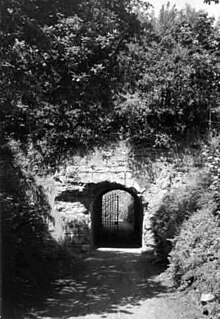Fort Loncin
Fort Loncin was one of the twelve fortifications around the Belgian city of Liege . It was built in 1888 according to the plans of General Henri Alexis Brialmont . In these works, concrete and reinforced concrete were used on a larger scale for the first time . It was destroyed in a German attack in World War I and was never rebuilt. Today it is one of the most important Belgian war memorials.
Form and position
The fort has the shape of an equilateral triangle with an area of one hectare and is surrounded by a moat ten meters deep and 15 meters wide. The fort is located about seven kilometers west of downtown Liège on the arterial road towards the Belgian capital, Brussels . The crew consisted of 500 artillerymen and 80 infantrymen .
The fort's armament was:
- Two 210 mm howitzers under an armored dome each
- Two 150 mm cannons in pairs under an armored dome
- Four 120 mm caliber cannons in pairs under an armored dome
- Four 57 mm caliber cannons each under an armored dome
- More rapid-fire cannons in 57 mm caliber and slots for machine guns
The heavy weapons and armored domes came mainly from the German Empire ; The Krupp cast steel factory in Essen and its subsidiary Grusonwerk (Magdeburg- Buckau ), which was taken over in 1893, were particularly well represented. The other part of the weapons came from Belgium.
Destruction in the First World War
At the beginning of the war , the forts of Liège were considered impregnable. Due to fortunate circumstances for the German attackers, the inner city could be taken on August 5, 1914. However, the twelve forts could only be taken during the siege of Liège , when the heaviest siege artillery with a caliber of 42 cm was brought in with the Dicken Bertha .
When this siege gun was bombarded on August 15, 1914, Fort Loncin received a direct hit in the ammunition chamber , which then exploded. The explosion killed 350 Belgian soldiers. The survivors went into German captivity , including the Belgian commander Gérard Leman .
consequences
The successful use of the Fat Bertha established the myth of the miracle weapon for this gun . The 42 cm caliber of this mortar became synonymous with it.
The cause of the rapid fall of the fort lay primarily in the fact that the ammunition chambers were too close to the surface. Another reason was the incorrect processing of the new material concrete. Both were avoided in the Belgian new buildings in the post-war period.
After the First World War, the fort was not rebuilt. Instead there is a military cemetery and a memorial site. The stamp of the Krupp factory can still be clearly seen on one of the cannons lying in place.
literature
- Louis Ruther: The Loncin Fort. Grave site and war memorial. Translated from the French by Günter Schalich. Loncin 2009.
See also
Web links
Coordinates: 50 ° 40 ′ 29 ″ N , 5 ° 29 ′ 31 ″ E


